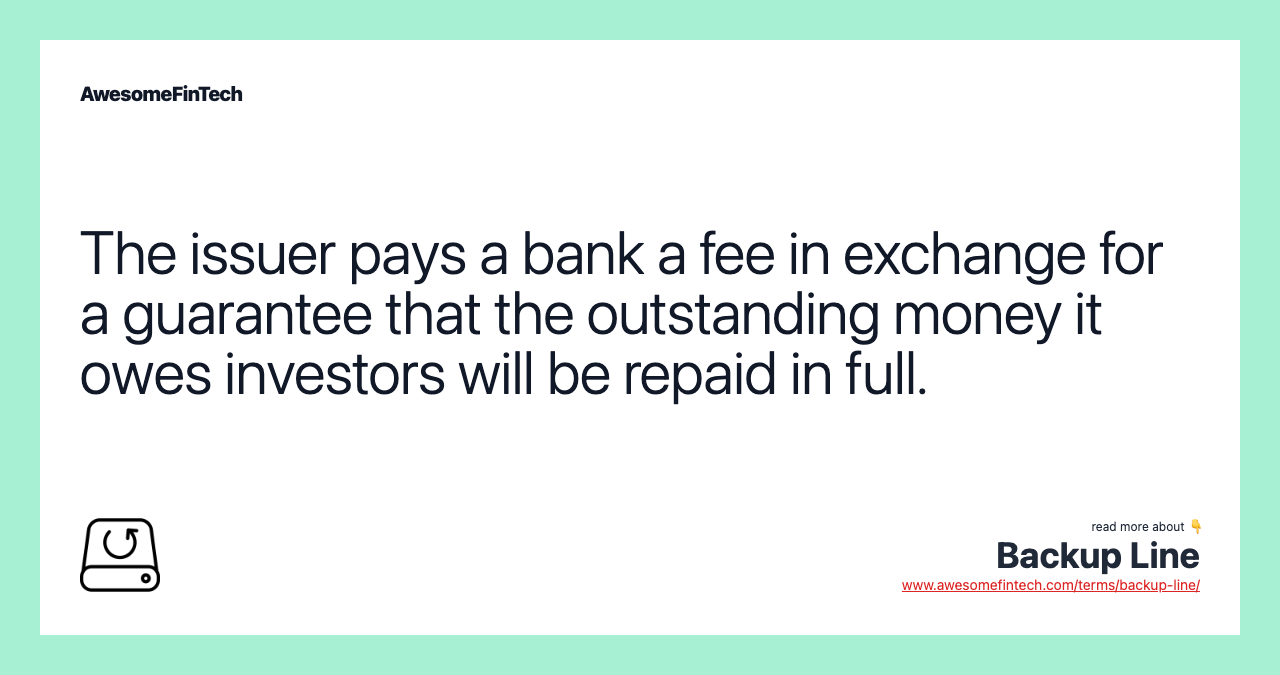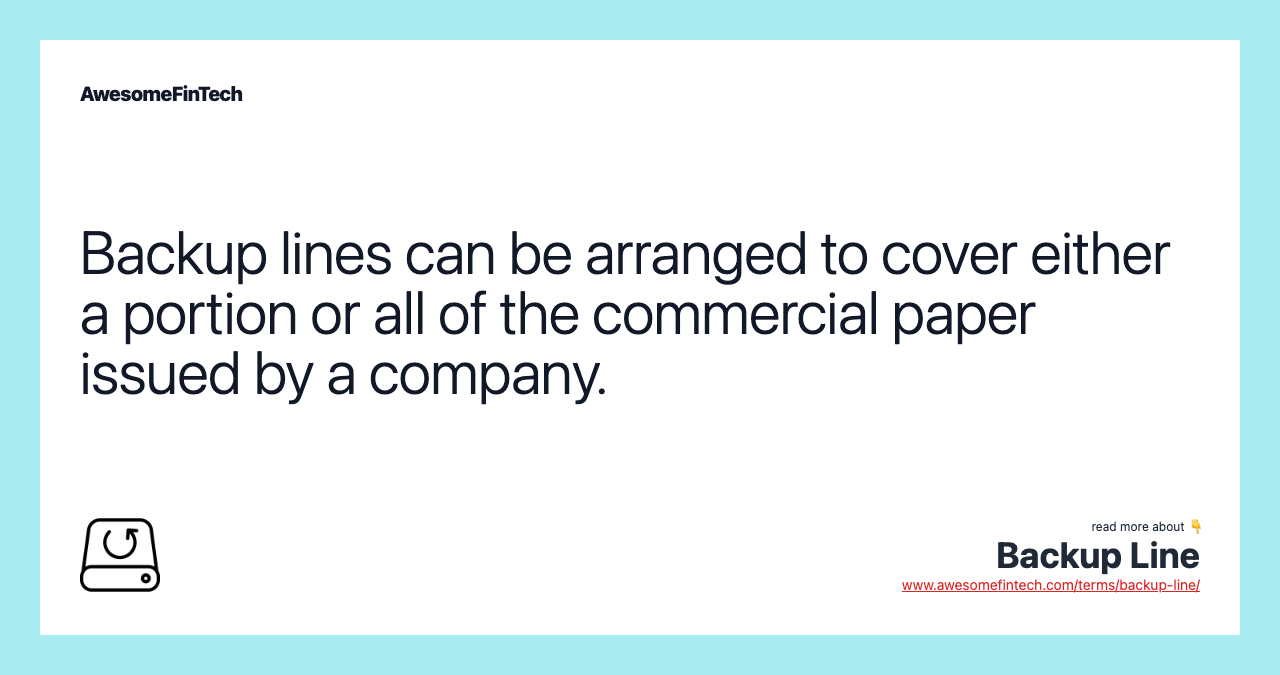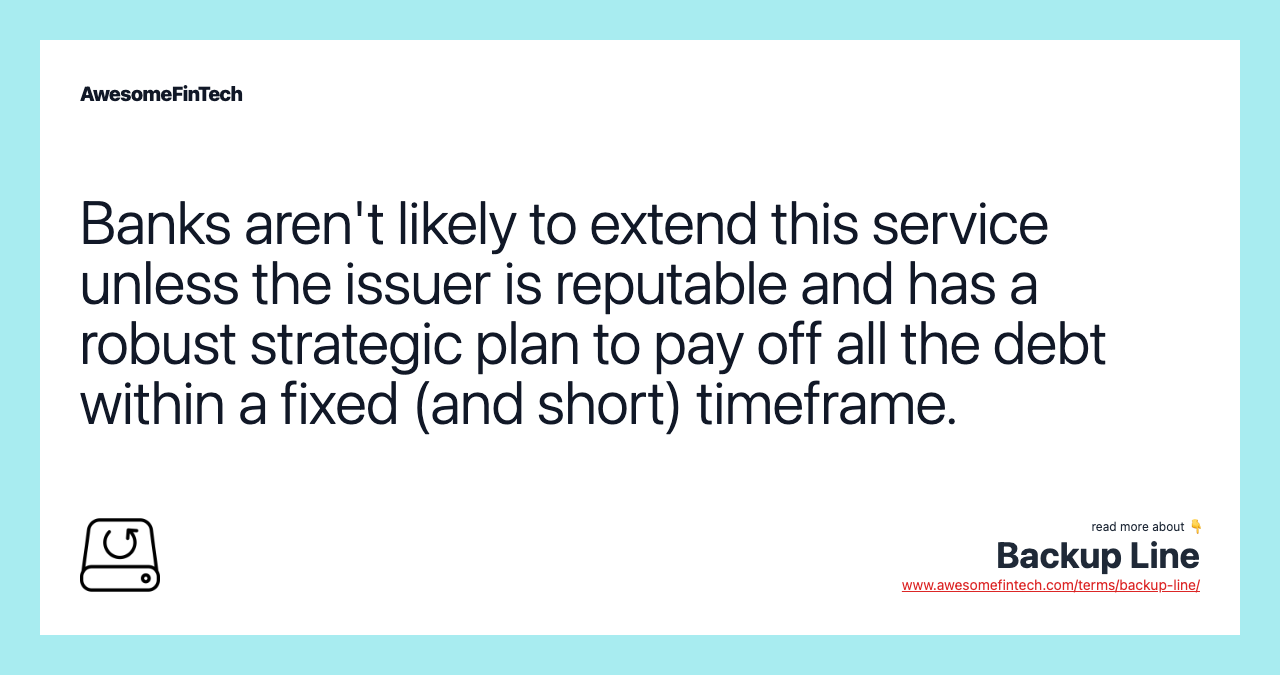Backup Line
A backup line is a line of credit (LOC) that protects investors in the event that a company defaults on its commercial paper: a type of unsecured, short-term debt instrument issued by corporations typically to finance payroll, accounts payable and inventories, and meet other short-term liabilities. A backup line is a line of credit (LOC) that protects investors in the event that a company defaults on its commercial paper: a type of unsecured, short-term debt instrument issued by corporations typically to finance payroll, accounts payable and inventories, and meet other short-term liabilities. A backup line is a line of credit (LOC) that protects investors in the event that a company defaults on its unsecured commercial paper. When the company decides to issue the commercial paper, it approaches a bank, describes the amount of commercial paper desired, and the strategy and the timeline for paying it off. The company issuing the paper pays a bank a fee in exchange for a guarantee that the outstanding money it owes investors will be repaid should it no longer be able to meet its obligations.

What Is a Backup Line?
A backup line is a line of credit (LOC) that protects investors in the event that a company defaults on its commercial paper: a type of unsecured, short-term debt instrument issued by corporations typically to finance payroll, accounts payable and inventories, and meet other short-term liabilities.
The company issuing the paper pays a bank a fee in exchange for a guarantee that the outstanding money it owes investors will be repaid should it no longer be able to meet its obligations.




How a Backup Line Works
Commercial paper is a cost-effective means of financing because it does not need to be registered with the Securities and Exchange Commission (SEC) — provided that it matures before nine months, or 270 days. Like any other type of bond or debt instrument, the issuer offers the paper assuming it will be in a position to pay both interest and principal by maturity.
It's not backed by any collateral, though. Commercial paper is unsecured, meaning if the company somehow goes bust investors won't get back what they are owed. One way around this is to acquire a backup line. The company pays a fee to a bank. In exchange, it receives a guarantee that commercial papers will be paid off if it defaults, helping to reassure and protect investors.
Important
Backup lines can be arranged to cover either a portion or all of the commercial paper issued by a company.
When the company decides to issue the commercial paper, it approaches a bank, describes the amount of commercial paper desired, and the strategy and the timeline for paying it off. Looking at the company's credit, the bank can then determine how much LOC it would guarantee the company, and at what cost.
The company will pay a fee, which acts as an insurance policy on the commercial papers. In other words, if the company cannot deliver on its promise, the bank will reimburse the remaining investors for what they are owed.
Example of a Backup Line
A retail company is seeking short-term funding to finance new inventory for an upcoming holiday season. The firm needs $10 million and offers investors $10.1 million in face value of commercial paper in exchange for $10 million in cash, according to prevailing interest rates.
Investors are willing to buy the paper because they have faith in the company and its excellent credit. That said, there is still a risk, albeit small, that the retailer could default on its promise to pay back the commercial paper.
To settle investors' nerves and eliminate this threat, the company decides to purchase a backup line. Though such a move comes at an expense, the retailer is also aware that access to this LOC should prompt investors to demand a lower financial reward for lending it capital.
Limitations of a Backup Line
Backup lines aren't easy to obtain or accessible to everyone. Banks aren't likely to extend this service unless the issuer of commercial paper is reputable and has a robust strategic plan to pay off all the debt within a fixed (and short) timeframe.
That helps to explain why only companies with excellent credit tend to issue commercial paper. Companies with poorer debt ratings will probably struggle to find buyers, unless they offer a substantial discount (higher cost) for the debt issue, or somehow find a way to convince a bank to cover its offering, which is also likely to come at a significant expense.
Related terms:
Accounting
Accounting is the process of recording, summarizing, analyzing, and reporting financial transactions of a business to oversight agencies, regulators, and the IRS. read more
Bank : How Does Banking Work?
A bank is a financial institution licensed as a receiver of deposits and can also provide other financial services, such as wealth management. read more
Banker's Acceptance (BA)
A banker's acceptance (BA) is like a post-dated check, but a bank rather than an account holder guarantees payment. BAs are sold at a discount in money markets. read more
Commercial Paper
Commercial paper is an unsecured debt instrument issued typically for the financing of a firm's short-term liabilities. read more
Credit
Credit is a contractual agreement in which a borrower receives something of value immediately and agrees to pay for it later, usually with interest. read more
Credit Rating
A credit rating is an assessment of the creditworthiness of a borrower—in general terms or with respect to a particular debt or financial obligation. read more
Debt Issue
A debt issue is a financial obligation that allows the issuer to raise funds by promising to repay the lender at a certain point in the future. read more
Default
A default happens when a borrower fails to repay a portion or all of a debt, including interest or principal. read more
Face Value
Face value is the nominal value or dollar value of a security stated by the issuer, also known as "par value" or simply "par." read more
Fine Paper
Fine paper refers to high grade securities whose credit rating makes them almost risk free with an extremely low probability of default. read more